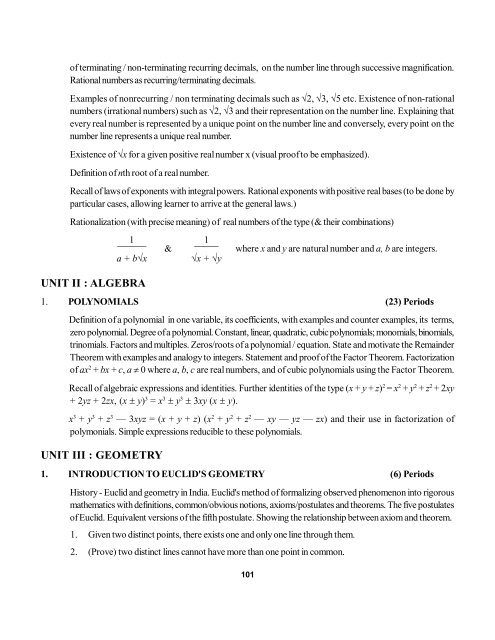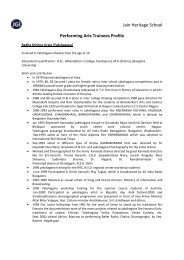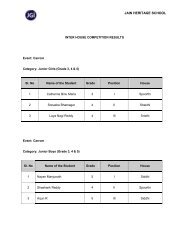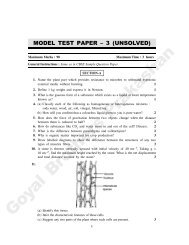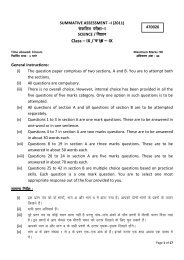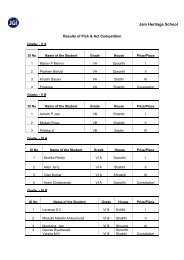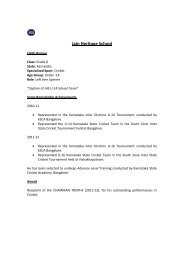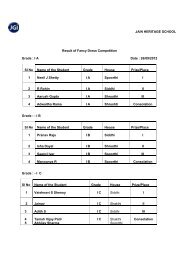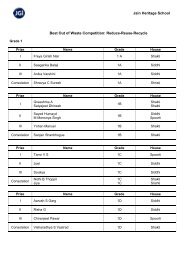Secondary School Curriculum 2012 - Central Board of Secondary ...
Secondary School Curriculum 2012 - Central Board of Secondary ...
Secondary School Curriculum 2012 - Central Board of Secondary ...
Create successful ePaper yourself
Turn your PDF publications into a flip-book with our unique Google optimized e-Paper software.
<strong>of</strong> terminating / non-terminating recurring decimals, on the number line through successive magnification.<br />
Rational numbers as recurring/terminating decimals.<br />
Examples <strong>of</strong> nonrecurring / non terminating decimals such as 2, 3, 5 etc. Existence <strong>of</strong> non-rational<br />
numbers (irrational numbers) such as 2, 3 and their representation on the number line. Explaining that<br />
every real number is represented by a unique point on the number line and conversely, every point on the<br />
number line represents a unique real number.<br />
Existence <strong>of</strong> x for a given positive real number x (visual pro<strong>of</strong> to be emphasized).<br />
Definition <strong>of</strong> nth root <strong>of</strong> a real number.<br />
Recall <strong>of</strong> laws <strong>of</strong> exponents with integral powers. Rational exponents with positive real bases (to be done by<br />
particular cases, allowing learner to arrive at the general laws.)<br />
Rationalization (with precise meaning) <strong>of</strong> real numbers <strong>of</strong> the type (& their combinations)<br />
______ 1<br />
a + bx<br />
&<br />
_____ 1<br />
x + y<br />
where x and y are natural number and a, b are integers.<br />
UNIT II : ALGEBRA<br />
1. POLYNOMIALS (23) Periods<br />
Definition <strong>of</strong> a polynomial in one variable, its coefficients, with examples and counter examples, its terms,<br />
zero polynomial. Degree <strong>of</strong> a polynomial. Constant, linear, quadratic, cubic polynomials; monomials, binomials,<br />
trinomials. Factors and multiples. Zeros/roots <strong>of</strong> a polynomial / equation. State and motivate the Remainder<br />
Theorem with examples and analogy to integers. Statement and pro<strong>of</strong> <strong>of</strong> the Factor Theorem. Factorization<br />
<strong>of</strong> ax 2 + bx + c, a 0 where a, b, c are real numbers, and <strong>of</strong> cubic polynomials using the Factor Theorem.<br />
Recall <strong>of</strong> algebraic expressions and identities. Further identities <strong>of</strong> the type (x + y + z) 2 = x 2 + y 2 + z 2 + 2xy<br />
+ 2yz + 2zx, (x y) 3 = x 3 y 3 3xy (x y).<br />
x 3 + y 3 + z 3 — 3xyz = (x + y + z) (x 2 + y 2 + z 2 — xy — yz — zx) and their use in factorization <strong>of</strong><br />
polymonials. Simple expressions reducible to these polynomials.<br />
UNIT III : GEOMETRY<br />
1. INTRODUCTION TO EUCLID'S GEOMETRY (6) Periods<br />
History - Euclid and geometry in India. Euclid's method <strong>of</strong> formalizing observed phenomenon into rigorous<br />
mathematics with definitions, common/obvious notions, axioms/postulates and theorems. The five postulates<br />
<strong>of</strong> Euclid. Equivalent versions <strong>of</strong> the fifth postulate. Showing the relationship between axiom and theorem.<br />
1. Given two distinct points, there exists one and only one line through them.<br />
2. (Prove) two distinct lines cannot have more than one point in common.<br />
101


